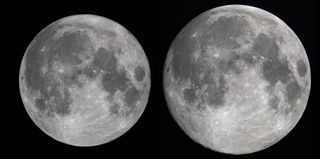'Super Pink Moon' rises tonight! Teach your kids about the biggest full moon of 2020
"It will be bright and brilliant and absolutely gorgeous."
NEW YORK — Tonight (April 7), if you look up at the night sky, you'll see the "Super Pink Moon," the biggest supermoon of the year, shining big and bright.
The full moon will be at perigee-syzygy, meaning it will be closest to the Earth — 221,772 miles (356,907 kilometers) away — and the Earth, moon and sun will all align. This means that when a the moon is at perigee-syzygy, it will look larger and brighter than usual. But, because perigee-syzygy isn't that catchy, the term "supermoon" came about and this particular full moon was additionally nicknamed the "Super Pink Moon."
Now, unfortunately, this doesn't mean that the moon will actually be pink. This supermoon got its name because the April full moon often corresponds with the blooming of pink flowers in eastern North America. Still, "It will be bright and brilliant and absolutely gorgeous," Jackie Faherty, an astronomer at the American Museum of Natural History here in New York City, told Space.com.
Related: How to watch the 'Super Pink Moon' online tonight!
More: Activities and resources for homebound kids: A coronavirus guide

Faherty added that, while you will be able to view this "Super Pink Moon" all night long as it rises, moves across the sky and sets, it will be especially breathtaking at moonrise. The spectacle is due to an optical illusion of sorts that occurs, as the moon is rising above the horizon that makes it appear larger. (You can search your local moonrise and moonset times here.)
A great learning opportunity
With so many people self-isolating at home with their families right now, this "Super Pink Moon" is a great opportunity to have some fun and learn, Faherty said.
Families can start studying the moon with their young children and this supermoon is a great place to start, Faherty said. Not only is the supermoon extra bright and beautiful, but even the name "pink moon" makes it even more exciting for kids.
Get the Space.com Newsletter
Breaking space news, the latest updates on rocket launches, skywatching events and more!
"This is an invitation for everybody to become that moon expert, be the person in that small group that can differentiate when the moon is just a little bit brighter," Faherty said.
Related: How to observe the moon with a telescope
More: Best telescopes for the money – 2020 reviews and guide
"I happen to be with my nieces right now, one of which is particularly obsessed with the moon," she said. She's been taking her nieces out next to the house at night to look at the moon and notice that every day it's a little bit different, and that doing something like that with young children is a great first introduction to the night sky.
"The most basic of the astronomical lessons you can do with a little one is the phases of the moon," she said.
More advanced moon-gazers of any age can take this opportunity to identify structures on the moon, she said. Without even needing binoculars, people can start recognizing basins and craters on the moon and even learn their names.
Related: Supermoon secrets: 7 surprising big moon facts
Studying the moon can be creative as well, Faherty said, suggesting that families teach both "the science of what's up there" and the cultural side of the night sky.
As families practice observing how the moon changes every night and findinging its structures, they can also come up with their own stories about the night sky, Faherty suggested. Parents can even prompt their children with questions like "Why would we have names for moons?" "What other names do we have for the moon?" and "What traditions do people have about the moon?"
"I sing little songs to my niece every night before she goes to bed about the moon and the earth and how much they love each other," Faherty said. "I think it's good for us all to remember we're creative people and the nighttime sky is a canvas."
Editor's note: If you have an amazing supermoon photo you'd like to share for a possible story or image gallery, you can send images and comments in to spacephotos@space.com.
OFFER: Save 45% on 'All About Space' 'How it Works' and 'All About History'!
For a limited time, you can take out a digital subscription to any of our best-selling science magazines for just $2.38 per month, or 45% off the standard price for the first three months.
- How the 'supermoon' looks (infographic)
- How to observe the moon with a telescope
- Supermoon and pink sky: Full moon rises against 'Belt of Venus'
Follow Chelsea Gohd on Twitter @chelsea_gohd. Follow us on Twitter @Spacedotcom and on Facebook.
OFFER: Save 45% on 'All About Space' 'How it Works' and 'All About History'!
For a limited time, you can take out a digital subscription to any of our best-selling science magazines for just $2.38 per month, or 45% off the standard price for the first three months.
Join our Space Forums to keep talking space on the latest missions, night sky and more! And if you have a news tip, correction or comment, let us know at: community@space.com.

Chelsea “Foxanne” Gohd joined Space.com in 2018 and is now a Senior Writer, writing about everything from climate change to planetary science and human spaceflight in both articles and on-camera in videos. With a degree in Public Health and biological sciences, Chelsea has written and worked for institutions including the American Museum of Natural History, Scientific American, Discover Magazine Blog, Astronomy Magazine and Live Science. When not writing, editing or filming something space-y, Chelsea "Foxanne" Gohd is writing music and performing as Foxanne, even launching a song to space in 2021 with Inspiration4. You can follow her on Twitter @chelsea_gohd and @foxannemusic.

